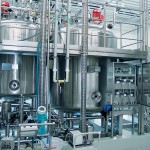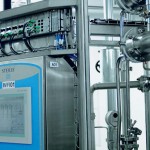Valve terminals not only offer cost advantages compared to automation solutions using individual pilot valves when it comes to investment; the total cost of ownership also speaks clearly in favour of platforms such as the CPX/MPA valve terminal. One of the reasons is the on-board electronics that provide extensive diagnostic functions to help avoid costly system downtimes. Through developments such as the Atex Zone 2 certification and the CPX-P interface, the use of valve terminals in the process industry is rapidly gaining ground.
Valve terminals are firmly established in factory automation. These neat valve manifolds with their piggy-backed electronics are employed in almost every discrete manufacturing process that uses pneumatics. The process industry, on the other hand, uses nowhere near as many of these clever base stations as one might expect. Yet valve terminals offer numerous advantages over individual pilot valves. The system solution’s first and foremost benefit is the clearly defined and standardised interface from the valve terminal to the fieldbus, such as Profibus DP. Valve terminal technology, unlike the individual valve concept, does not need the binary output of remote I/Os to actuate the individual valves, which in turn eliminates the need for wiring, cable laying and other secondary activities. This means that in large systems that are not too widely distributed, several hundred binary outputs – and the planning they require – can often be dispensed with. This not only saves money during installation, but also reduces maintenance costs.
The use of valve terminals also renders pneumatic ring circuits with pneumatic manifolds superfluous in many instances. These often account for a significant portion of the investment costs in new projects and are a common source of leaks in systems that are already up and running. Further advantages of this intelligent valve platform are its quick and easy installation as well as the far more systematic approach to commissioning than when using individually distributed pilot valves.
For a comprehensive cost comparison there are other important factors that have to be taken into consideration. From a cost point of view, reliable operation of a system is ultimately more important than the investment, i.e. the construction of the system up to its installation. The successful implementation of a system concept isn’t revealed until operation starts. And it is only with a standardised and functioning condition monitoring concept that users can reduce costly unplanned system downtimes. The CPX/MPA valve terminal concept from Festo, a combination of the remote I/O terminal CPX and the solenoid valve terminal MPA, increases system availability thanks to convenient maintenance and diagnostics options. The MPA has its own chip (Festo ASIC) for this purpose. This electronic module facilitates valve-specific diagnostics for each solenoid coil. It is able to monitor the coil current and detect undervoltage, short circuits or open circuits. An integrated diagnostic memory stores these messages together with a timestamp. The data is displayed on the valve via a multi-coloured LED, a handheld (CPX-MMI) directly in the field as well as a fieldbus or Ethernet (web server). After all, one minute of downtime in a top-level production facility can cost a lot of money.
Valves and drives have mechanical parts that can wear and therefore need regular maintenance or adjustment. Preventative maintenance functions provide timely re-minders of maintenance intervals. CPX/MPA can even provide warnings via e-mail or SMS text message. This is done by means of a series of continuous switching cycle counters (one for each valve solenoid) integrated in the electronic module of the MPA that generate a message when a setpoint value is reached. Further integrated features for preventative maintenance include a diagnostic trace with error memory as well as continuous monitoring of the coil currents and coil voltage for solenoid valves. This permits early detection of any increase in sporadic faults. Up to now, this was usually not detected until the individual components had failed.
For the hygiene technology provider Steris Finn-Aqua, these convenient options were the decisive factor in choosing the CPX/MPA valve terminal. After all, it is difficult to implement the current requirements of the Food and Drug Administration (FDA) for Process Analytical Technology (PAT) without an effective diagnostic concept. The company now integrates the CPX/MPA in its multi-effect water distillation systems for the production of ultra-pure water for the pharmaceutical industry. “Apart from the extensive diagnostics options, with the CPX/MPA we also save 30 % on installation costs“, explains Veli-Jukka Parkkamäki, Engineering Manager at Steris Finn-Aqua.
Attentive observers will soon find valve terminal solutions in completely different areas of process automation. Whereas potentially explosive zones were off limits for the CPX/MPA platform until recently, the powerful valve terminal can now be ordered with Zone 2 Atex certification. This certification means the terminals can also be installed in hazardous areas, namely up to Zone 2 for gas hazards and up to Zone 22 for dust hazards. As far as explosion protection goes, there is thus no reason why in the future CPX/MPA cannot be used in many systems within the chemical industry – provided the process valves are not too far apart.
Process interface with intrinsically safe design
The electrical terminal CPX-P paves the way for further functional integration and is specially tailored to processing specific signal types in process automation. This terminal facilitates the connection of Namur sensors among other things, but also of analogue sensors and actuators. In addition, it is particularly safe. For the first time there is an intrinsically safe process interface with IP 65 protection available. All CPX-P modules are also available in an intrinsically safe design suitable for use in all zones up to Zone 0.
cpp 429
CPX
MPA
Homepage
Share:









